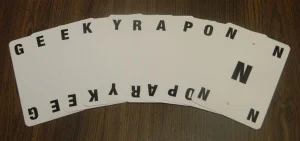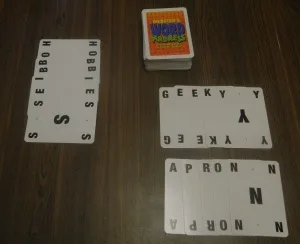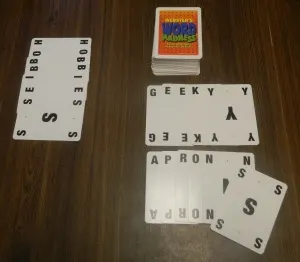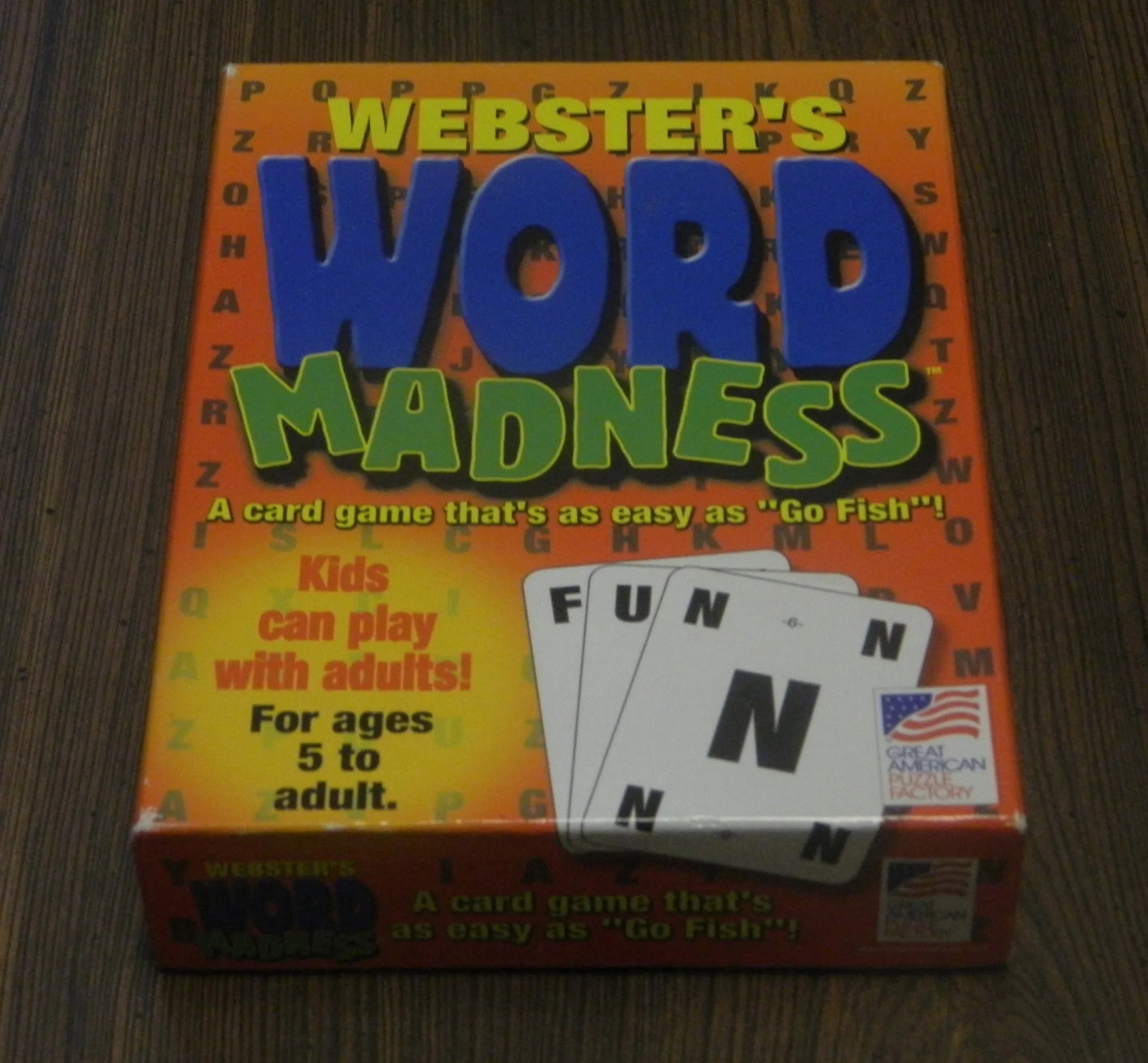How to Play:
“Word Madness” is a card game that bizarrely combines a word game with “Go Fish.” To start the game, the cards are shuffled and ten cards are dealt to each player (the game can accommodate 2 to 6 players or even 2 to 6 teams). The game says that kids 7 and under should get only 7 cards, which I think is a good rule that should be used if you plan to play with your younger children (it would be very hard for them to use all ten cards).

After the cards are dealt, play beings with a “two-minute spellout” where each player attempts to use as many of their letter cards to form words as they can in two minutes. Words must be 4 or more letters and may not be proper nouns or slang terms unless agreed upon ahead of time (for children, the game recommends that 3 or more letter words and words of any kind are accepted). Once you have placed down a word, you may not pick it back up again (not even a single letter you later realize you need for another word). The goal is to be the first player to play all ten of your letter cards (by creating either two five-letter words or four and six letter words), either during the spellout round or the “go fish” round (which I explain next).

If nobody uses all ten of their cards during the spellout (which rarely happened in the two games I played but over a larger sample size would probably happen at least 50% of the time), they still play the best words they can create and keep the rest of their cards for the “Go Fish” round. In this round, the player to the left of the dealer starts and asks a player of their choice for a letter they need to create a word using the other cards in their hand or to add to a word already on the table (for example, adding an “s” to pluralize a word). If the player does have the letter asked for, they give them all of them they have (if they are asked for an “e” and have four of them, they give them all four). If not, they say “go fish” and the other player draws the top card from the draw pile and ends their turn (unless they get the letter they asked for, in which case they show it to everyone and their turn continues). If they do receive a card from another player, their turn continues. They can play new words (this can be done at any time during your turn), add letters to any words already on the table, and/or ask for another letter from any player. When they finally have to go fish, they draw the top card from the draw pile and their turn ends (unless they get the letter they asked for when drawing). Players can play cards on anybody’s word they want but this also lengthens that player’s word which will give them more points when the round ends (they’ll effectively get as many points as you did for adding the letter). For each letter added to an opponent’s word, the player immediately adds 50 points to their score (all other scoring is done at the end of the round). Play continues clockwise until someone has used all of the cards in their hand to form new words or adds them to already-formed words on the table.

When somebody uses up all their cards by making new words and/or adding to pre-existing words, the round ends and scoring begins. The only scoring done before this is the 50 points per letter players receive for adding to their opponents’ words. There are a lot of different scoring rules so I’ll explain them the best I can. The first player to use all their letter cards gets a 200-point bonus (no matter if it was during the two-minute spellout or “go fish” round). If they go out during the two-minute spellout, they receive a 100-point bonus (for a total of 300 points). These bonuses only apply to the first player to finish their hand. For players still holding cards at the end of the round, they lose 5 points for each letter in their hand.
Players also get points for each of the words they played based on how long they are (4 letters = 50 points, 5 letters = 100 points, 6 letters = 150 points, 7 letters = 200 points, 8 letters = 250 points, 9 letters = 300 points, and 10 or more letters = 500 points). For children, the scoring goes 3 letters = 50 points, 4 letters = 100 points, 5 letters = 150 points, 6 letters = 200 points, 7 letters = 250 points, and 8 or more letters = 500 points. Even if other players added to your word, you get the points for the full length of the word. If you use a J, Q, X, or Z in your word, that word gets double value (so a 6 letter word with a Q in it would give the player 300 points instead of 150). If two are used in the same word, the value is tripled (so “jazz” would give the player 150 points instead of 50). If a player uses all four of those letters (not necessarily in the same word), they get a 500-point bonus as well as the other multiplied points for the words themselves.
You can also score points by challenging opponent’s words while the round is still going (you challenge if the word was misspelled or not). If your challenge is successful, you receive 100 points and the other player must pick up the letters (you can even challenge a word you know is incorrect than ask for the letters they just picked up during your turn).
After someone goes out and all the scoring is tallied, a new round is played in the exact same way (starting with the spellout). New rounds are played until someone gets to 2000 total points, in which case they are named the winner.
My Thoughts:
I’m really good at word games and generally enjoy them, so I’m not surprised that I actually enjoyed “Word Madness” quite a bit. However, I will admit that other than the “go fish” element the game is very similar to a lot of other word games. There are likely hundreds of board and card games where the goal is to form words and a lot of them even use letter cards like this one. I can’t think of the game offhand but I know I have played a very similar game to this before.
The best part of the game is definitely the spellout. You wouldn’t think it would be easy to use all ten cards to form two words in just two minutes, but it happens far more often than you would think. There are really only two scenarios where it is hard to get rid of most or all of your cards: you get stuck with a lot of the less frequently used letters (there are usually only two of each of these in the deck of 112 letter cards so it shouldn’t happen often) or you draw few or almost all vowel cards (ideally you’ll get around four or five vowels). Otherwise, two minutes is usually enough to get rid of most of your cards. There were a couple rounds where I found two easy words in my hand and finished in the first 30-45 seconds. I would actually consider using the “simpler version for younger players” which only uses the two-minute spellout, since I wasn’t a big fan of the “go fish” round but did enjoy the spellout phase.
The “go fish” round doesn’t really add much to the game, except a bit of luck. Unless your opponents got stuck with a lot of unappealing letters, they will likely only have one or two cards remaining when this round begins. This makes guessing a letter the other player has really hard (especially since you’ll probably want a commonly used letter and they’ll probably just have lesser used ones at this point). This makes drawing well almost a necessity to win during the “go fish” part of the game. This round varies significantly in length, I could see a scenario where the first player has cards they can just add to other peoples’ words and end the round before even asking for a card (thus not even giving the other players a chance to win the round). In the games I played, there was at least one marathon “go fish” round where the players all had large hands and kept adding to them by having to always draw from the draw pile.
The “go fish” round does have some interesting mechanics and strategies. In some cases, an opponent could help you by asking for a letter you don’t want to use (or if you somehow have a hand with 3 or 4 of a single letter, you will get rid of all of them and reduce your hand substantially). It is pretty hard to form new words during this phase (and even if you do, you’ll likely draw some bad letters that will be hard to get rid of) since you’ll probably need to use some common letters and those are usually what your opponents will ask for (they might steal and use one you need before you can finish the word). This can lead to some long “go fish” rounds.
While I did enjoy “Word Madness,” I must admit that it has some pretty serious flaws. First of all, there is nearly nothing original about it. There are so many word games out there and a lot of them are very similar to “Word Madness.” The only thing that is semi-original is the “go fish” element, which I’m not a big fan of. The game is perfectly playable and fun, it’s just that there are better word games out there. Word games usually have a pretty boring look to them but I doubt most of them are as boring looking as this one. The cards simply show the letter and have a number indicating how many of them are in the deck and this is presented in the most boring way possible. Clearly, not much time was spent on the design of the game.
One thing that is a definite positive about “Word Madness” is the fact that they included rules tweaks for playing with younger children. This is a semi-educational game so its very nice of the Great American Puzzle Factory to provide rules that even things out for kids and adults. More games should provide a list of suggested rules to even the playing field.
If I could add a rule to the game, I would consider dividing the vowels and consonants into two different decks. I was extremely lucky with my hands in most cases but there were times when my opponents where stuck with too many or too few vowels. Giving each player four vowels and six consonants would probably be ideal and make things much fairer (it’s kind of hard to make two words or an extremely long one with just one vowel).
Final Verdict:
“Word Madness” isn’t a bad game by any means (I even liked the game and gave it a completely average 3 out of 5), it just isn’t original and there are better word game options out there. If you like word games and find it at a thrift store or rummage sale for $0.50 or a couple dollars, it is probably worth a try but don’t expect anything original. You probably even have something similar to it in your game library if you are a word game fan.


My Word! Card Game Review and Instructions | Geeky Hobbies
Thursday 21st of May 2015
[…] the game is that it is just not original. I have actually played a game that is very similar in Word Madness. There are probably several other card games that are very similar to My Word. Since the game is not […]